Wednesday, January 4, 2012
eHarmony's matching algorithm, the truth. part 1 of 3
eHarmony has 2 bogus patents about its Compatibility Matching Algorithm, none of them explains in detail the actual Compatibility Matching Algorithm in use in their sites.
eHarmony, a 11+ years old obsolete site, uses a Compatibility Matching Algorithm based on personality similarity with the Big5 normative personality test and Dyadic Adjustment Scale (invented by Dr. Graham B. Spanier in 1976) as its core. The Guided Communication Process (a mutual filtering step) is an appendix of its main matching algorithm.
eHarmony is not "scientifically proven" because eHarmony Labs could not prove eHarmony's matching algorithm can match prospective partners who will have more stable and satisfying relationships -and very low divorce rates- than couples matched by chance, astrological destiny, personal preferences, searching on one's own, or other technique as the control group in a peer reviewed Scientific Paper.
eHarmony's Compatibility Matching Algorithm consists of 2 stages.
* A mutual filtering stage common to any online dating site like PlentyOfFish, Match, Chemistry, True, PerfectMatch, Parship, MeeticAffinity, OkCupid, Be2, FriendScout24, etc.
* The core stage.
The mutual filtering stage includes your race, age range, physical appearance, income, religion, leisure activities and sports, skills, location, drinking and smoking habits, likes & dislikes, if you want children or if you have children under 18 living with you, pets, etc. and the same items you will desire in any prospective partner.
The core stage of eHarmony's Compatibility Matching Algorithm:
1) The normative Big5 test to assess personality (The Big 5 is good for orientative purposes but not good enough for predictive purposes)
2) Dyadic Adjustment Scale (invented in 1976) to calculate compatibility (similarity) between prospective mates.
3) The Guided Communication Process (a mutual filtering step) designed to narrow even more the field of persons you give a better chance of getting along with, and also it is useful for feedback purposes.
(to be continued in part 2)
Subscribe to:
Post Comments (Atom)



No comments:
Post a Comment